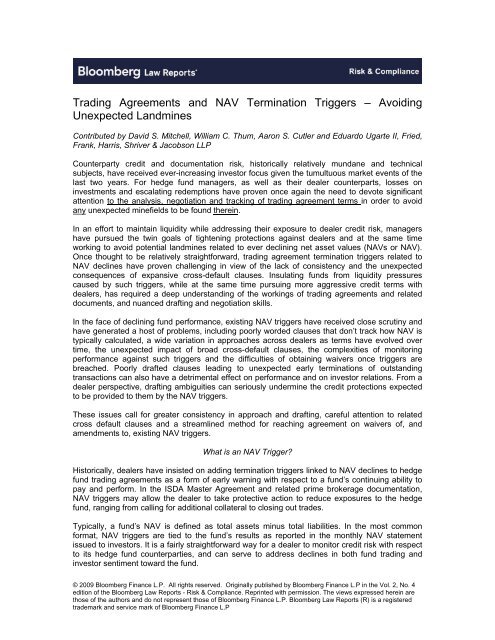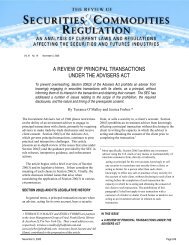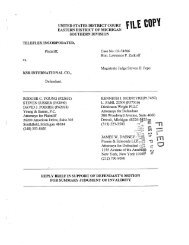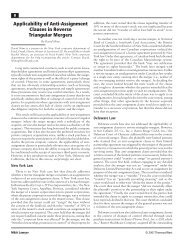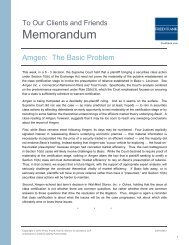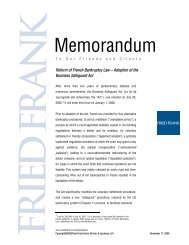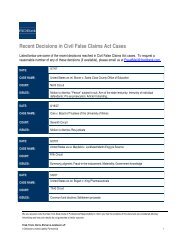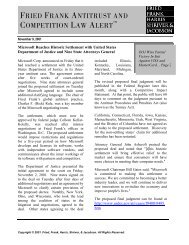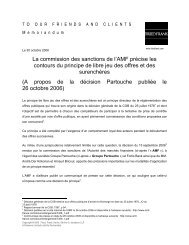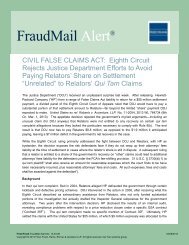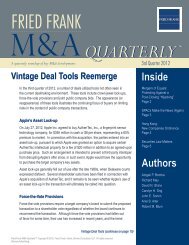Trading Agreements and NAV Termination Triggers ... - Fried Frank
Trading Agreements and NAV Termination Triggers ... - Fried Frank
Trading Agreements and NAV Termination Triggers ... - Fried Frank
You also want an ePaper? Increase the reach of your titles
YUMPU automatically turns print PDFs into web optimized ePapers that Google loves.
<strong>Trading</strong> <strong>Agreements</strong> <strong>and</strong> <strong>NAV</strong> <strong>Termination</strong> <strong>Triggers</strong> – AvoidingUnexpected L<strong>and</strong>minesContributed by David S. Mitchell, William C. Thum, Aaron S. Cutler <strong>and</strong> Eduardo Ugarte II, <strong>Fried</strong>,<strong>Frank</strong>, Harris, Shriver & Jacobson LLPCounterparty credit <strong>and</strong> documentation risk, historically relatively mundane <strong>and</strong> technicalsubjects, have received ever-increasing investor focus given the tumultuous market events of thelast two years. For hedge fund managers, as well as their dealer counterparts, losses oninvestments <strong>and</strong> escalating redemptions have proven once again the need to devote significantattention to the analysis, negotiation <strong>and</strong> tracking of trading agreement terms in order to avoidany unexpected minefields to be found therein.In an effort to maintain liquidity while addressing their exposure to dealer credit risk, managershave pursued the twin goals of tightening protections against dealers <strong>and</strong> at the same timeworking to avoid potential l<strong>and</strong>mines related to ever declining net asset values (<strong>NAV</strong>s or <strong>NAV</strong>).Once thought to be relatively straightforward, trading agreement termination triggers related to<strong>NAV</strong> declines have proven challenging in view of the lack of consistency <strong>and</strong> the unexpectedconsequences of expansive cross-default clauses. Insulating funds from liquidity pressurescaused by such triggers, while at the same time pursuing more aggressive credit terms withdealers, has required a deep underst<strong>and</strong>ing of the workings of trading agreements <strong>and</strong> relateddocuments, <strong>and</strong> nuanced drafting <strong>and</strong> negotiation skills.In the face of declining fund performance, existing <strong>NAV</strong> triggers have received close scrutiny <strong>and</strong>have generated a host of problems, including poorly worded clauses that don’t track how <strong>NAV</strong> istypically calculated, a wide variation in approaches across dealers as terms have evolved overtime, the unexpected impact of broad cross-default clauses, the complexities of monitoringperformance against such triggers <strong>and</strong> the difficulties of obtaining waivers once triggers arebreached. Poorly drafted clauses leading to unexpected early terminations of outst<strong>and</strong>ingtransactions can also have a detrimental effect on performance <strong>and</strong> on investor relations. From adealer perspective, drafting ambiguities can seriously undermine the credit protections expectedto be provided to them by the <strong>NAV</strong> triggers.These issues call for greater consistency in approach <strong>and</strong> drafting, careful attention to relatedcross default clauses <strong>and</strong> a streamlined method for reaching agreement on waivers of, <strong>and</strong>amendments to, existing <strong>NAV</strong> triggers.What is an <strong>NAV</strong> Trigger?Historically, dealers have insisted on adding termination triggers linked to <strong>NAV</strong> declines to hedgefund trading agreements as a form of early warning with respect to a fund’s continuing ability topay <strong>and</strong> perform. In the ISDA Master Agreement <strong>and</strong> related prime brokerage documentation,<strong>NAV</strong> triggers may allow the dealer to take protective action to reduce exposures to the hedgefund, ranging from calling for additional collateral to closing out trades.Typically, a fund’s <strong>NAV</strong> is defined as total assets minus total liabilities. In the most commonformat, <strong>NAV</strong> triggers are tied to the fund’s results as reported in the monthly <strong>NAV</strong> statementissued to investors. It is a fairly straightforward way for a dealer to monitor credit risk with respectto its hedge fund counterparties, <strong>and</strong> can serve to address declines in both fund trading <strong>and</strong>investor sentiment toward the fund.© 2009 Bloomberg Finance L.P. All rights reserved. Originally published by Bloomberg Finance L.P in the Vol. 2, No. 4edition of the Bloomberg Law Reports - Risk & Compliance. Reprinted with permission. The views expressed herein arethose of the authors <strong>and</strong> do not represent those of Bloomberg Finance L.P. Bloomberg Law Reports (R) is a registeredtrademark <strong>and</strong> service mark of Bloomberg Finance L.P
Indeed, investor withdrawals <strong>and</strong> redemptions can compound already significant <strong>NAV</strong> declinesarising from poor performance. Although investor redemptions can stem from fading confidencein the fund, they can also relate to more benign factors, such as an investor’s need for liquidity tobuy a house, finance a child’s education, or any number of non-market motivations. It is alsoimportant to consider that a hedge fund may have a flat or improving <strong>NAV</strong>, even in times of poorperformance, if investor subscriptions keep pace with, or exceed, trading losses.<strong>Termination</strong> triggers related to <strong>NAV</strong> are generally added as an Additional <strong>Termination</strong> Event inthe Schedule to the ISDA Master Agreement <strong>and</strong> as an event of default in related primebrokerage documentation. Such events are triggered when a fund’s <strong>NAV</strong> declines below aspecified level over a specified period. <strong>NAV</strong> triggers have at least four common variables: 1) thedecline threshold; 2) the period during which a decline is measured; 3) the starting <strong>and</strong> stoppingpoint of such measurement; <strong>and</strong> 4) the <strong>NAV</strong> components measured.In a basic example, an event triggered by a 30% decline in <strong>NAV</strong> in a one-month period isbreached if the fund's current month-end <strong>NAV</strong> reflects a decline from the fund’s prior month-end<strong>NAV</strong> of at least 30%, i.e., a $10,000,000 hedge fund has declined to $7,000,000.Problems with <strong>NAV</strong> <strong>Triggers</strong><strong>NAV</strong> triggers used in trading agreements across dealers present a tremendous diversity inapproach. Examples include <strong>NAV</strong> triggers that measure fund performance at periodic intervals(e.g., one-month, three-months or twelve-months); from a high-water mark; against the priorcalendar/fiscal year-end; <strong>and</strong>/or against an overall floor. <strong>NAV</strong> components measured mayaddress trading performance only, or may include the impact of investor redemptions,withdrawals <strong>and</strong>/or subscriptions.In addition, typical cross-default clauses are used to import termination triggers (including <strong>NAV</strong>triggers) specified in other agreements, whether between the parties or involving third parties.Dealers insist on such clauses to level the playing field by taking advantage of better termsagreed to by the fund with other dealers. Depending on the scope of the clauses, they caneffectively serve to reduce such triggers to the lowest common denominator agreed to by a hedgefund with other dealer counterparties.Period-end <strong>NAV</strong> triggers vs. Any-day <strong>NAV</strong> triggersTo test if a fund’s <strong>NAV</strong> has breached a trigger, at least two starting points for the test are possibleincluding 1) a prior month-end <strong>NAV</strong> level (Period-end <strong>NAV</strong> trigger) or 2) a prior <strong>NAV</strong> level on anyday (Any-day <strong>NAV</strong> trigger) - such as the highest <strong>NAV</strong> level achieved during the relevant timeperiod. Similarly, the end point of the test can be 1) the current month-end <strong>NAV</strong> level or 2) thecurrent <strong>NAV</strong> level on any day.For example, a three-month Period-end <strong>NAV</strong> trigger tests the current month-end <strong>NAV</strong> against themonth-end <strong>NAV</strong> level of the third previous calendar month. A three-month Any-day <strong>NAV</strong> triggermay test the current <strong>NAV</strong> against the highest <strong>NAV</strong> achieved since the end of the third previouscalendar month.Whereas the Period-end <strong>NAV</strong> trigger is relatively straightforward, the Any-day <strong>NAV</strong> trigger canpresent a number of complexities. At issue is whether the trigger addresses the high pointachieved at a month-end prior to the starting point or that achieved on any day during the relevantperiod. Likewise, the end point could test the <strong>NAV</strong> level at the current month-end or at any day.As funds typically report <strong>NAV</strong> on a month-end basis in a statement distributed to investors,referencing the month-end numbers greatly simplifies the analysis. Given the difficulty associatedwith obtaining reporting with respect to interim (any day) estimates of <strong>NAV</strong>, <strong>and</strong> that such© 2009 Bloomberg Finance L.P. All rights reserved. Originally published by Bloomberg Finance L.P in the Vol. 2, No. 4edition of the Bloomberg Law Reports - Risk & Compliance. Reprinted with permission. The views expressed herein arethose of the authors <strong>and</strong> do not represent those of Bloomberg Finance L.P. Bloomberg Law Reports (R) is a registeredtrademark <strong>and</strong> service mark of Bloomberg Finance L.P
In both the 1992 <strong>and</strong> 2002 versions of the ISDA Master Agreement, such clauses include DefaultUnder Specified Transactions (DUST) (at Section 5(a)(v)) <strong>and</strong> Cross Default (at Section 5(a)(vi)).While DUST typically targets defaults involving other derivatives trading agreements between theparties <strong>and</strong> related entities, the Cross Default clause targets defaults exceeding a thresholdinvolving borrowed money owed to third parties. Similar clauses appear in dealer primebrokerage agreements <strong>and</strong> elsewhere.Where the st<strong>and</strong>ard ISDA clauses have been amended to include defaults involving derivativetransactions with third parties, <strong>NAV</strong> triggers occurring in such agreements may be imported tocloseout outst<strong>and</strong>ing trades under the ISDA. Where the ISDA agreements have also beenamended to require parties to provide notices of Events of Default or Potential Events of Default,a fund could find itself obligated to provide Dealer A with notice of its breach of an <strong>NAV</strong>termination trigger with Dealer B - even if the <strong>NAV</strong> trigger agreed with Dealer A has not yet beenbreached.<strong>NAV</strong> Trigger Issues <strong>and</strong> SolutionsAmbiguous drafting, triggers linked to interim (any day) <strong>NAV</strong>, mixed approaches to theinclusion/exclusion of investor activity <strong>and</strong> exp<strong>and</strong>ed cross default clauses all demonstrate theneed for a greater degree of precision <strong>and</strong> consistency with respect to the drafting of <strong>NAV</strong>termination triggers.Adding to the complexity is the scenario where different agreements (sometimes with the samedealer) have different definitions of <strong>NAV</strong> <strong>and</strong> different <strong>NAV</strong> termination triggers, so that multiplevariables need to be considered when monitoring triggers against monthly <strong>NAV</strong> performance.These differences in approach add to the complexity of a fund’s efforts to monitor its tradingagreement <strong>NAV</strong> triggers as it seeks to maintain its overall liquidity, as well as respond to adealer’s efforts to manage credit risk.Consistent TermsWhile tailored approaches are required in the context of different fund sizes, levels ofmanagement expertise, trading strategies, etc., going forward, a more consistent structure interms of drafting, definitions <strong>and</strong> approach is useful to allow funds to monitor liquidity risks <strong>and</strong>dealer counterparties to address credit risk more efficiently.Given that hedge fund <strong>NAV</strong> is typically calculated on a month-end basis <strong>and</strong> distributed toinvestors in a monthly statement, references to interim estimates of <strong>NAV</strong> present serious practicalcomplexities in terms of production <strong>and</strong> tracking which compromise their utility as actionabletermination triggers. For these reasons only <strong>NAV</strong> calculated as of the close of business on thelast calendar day of each calendar month should serve as a practical trigger.More compelling is an approach involving a combination of Period-end <strong>NAV</strong> triggers including: 1)short-term triggers (e.g. declines over one, three <strong>and</strong> twelve months) targeting tradingperformance, excluding the impact of redemptions, withdrawals <strong>and</strong> subscriptions; <strong>and</strong> 2) overallfloor triggers addressing both trading performance <strong>and</strong> investor activity, including redemptions,withdrawals <strong>and</strong> subscriptions.Great care needs to be given to the drafting of cross default clauses to ensure that where defaultson other derivative transactions are to be imported, the acceleration of the other tradingagreement must be required (<strong>and</strong> not merely a breach of the <strong>NAV</strong> trigger in the other tradingagreement). The added requirement for acceleration of the underlying agreement is meant toensure that the termination event merits a serious response. Moreover, it is critical that anappropriate default threshold is specified, preferably based upon the net amount outst<strong>and</strong>ing afteracceleration of the other trading agreement (after application of any collateral or other creditsupport) to ensure that only significant defaults are imported.© 2009 Bloomberg Finance L.P. All rights reserved. Originally published by Bloomberg Finance L.P in the Vol. 2, No. 4edition of the Bloomberg Law Reports - Risk & Compliance. Reprinted with permission. The views expressed herein arethose of the authors <strong>and</strong> do not represent those of Bloomberg Finance L.P. Bloomberg Law Reports (R) is a registeredtrademark <strong>and</strong> service mark of Bloomberg Finance L.P
ConclusionHedge funds aiming to protect trading liquidity need to pay careful attention to <strong>NAV</strong> triggers intheir trading agreements with dealers. Whether dealer remedies include trade termination rightsor additional collateral calls, <strong>NAV</strong> trigger breaches can have a severe impact on fund liquidity.Broad cross default clauses may allow the <strong>NAV</strong> trigger breaches to be imported across tradingrelationships. Such events may also need to be disclosed to investors.Given the seriousness of the potential consequences, it is imperative that hedge funds develop arobust approach including careful attention to drafting, close monitoring of <strong>NAV</strong> triggers <strong>and</strong>prompt resolution of any breaches through the use of waivers, resets <strong>and</strong> amendments. It isparticularly important to address these issues in the current environment of market volatility <strong>and</strong>investor unease.Mr. Mitchell, Mr. Thum, Mr. Cutler <strong>and</strong> Mr. Ugarte are attorneys in the Asset Management Groupof <strong>Fried</strong>, <strong>Frank</strong>, Harris, Shriver & Jacobson LLP. Mr. Mitchell is a Partner resident in the NewYork, NY office <strong>and</strong> Mr. Thum is Senior Derivatives Advisor resident in the New York, NY office.Mr. Cutler <strong>and</strong> Mr. Ugarte are both Associates in the Washington, DC office. This article reflectsthe views of the authors, <strong>and</strong> does not constitute legal advice. Mr. Mitchell can be reached atdavid.mitchell@friedfrank.com, Mr Thum can be reached at william.thum@friedfrank.com, Mr.Cutler can be reached at aaron.cutler@friedfrank.com, <strong>and</strong> Mr. Ugarte can be reached ateduardo.ugarte@friedfrank.com.1 We refer to <strong>NAV</strong> triggers to include both <strong>NAV</strong> triggers <strong>and</strong> <strong>NAV</strong> floors collectively, unless we noteotherwise.2 In Part 4 of the Schedule to both the 1992 <strong>and</strong> 2002 version of the ISDA Master Agreement, partiesgenerally specify the requirement for a fund to provide a statement of the fund’s month-end <strong>NAV</strong> levelwithin a specified period following such month end. The length of the period depends on the outcome ofthe parties’ negotiation.© 2009 Bloomberg Finance L.P. All rights reserved. Originally published by Bloomberg Finance L.P in the Vol. 2, No. 4edition of the Bloomberg Law Reports - Risk & Compliance. Reprinted with permission. The views expressed herein arethose of the authors <strong>and</strong> do not represent those of Bloomberg Finance L.P. Bloomberg Law Reports (R) is a registeredtrademark <strong>and</strong> service mark of Bloomberg Finance L.P


